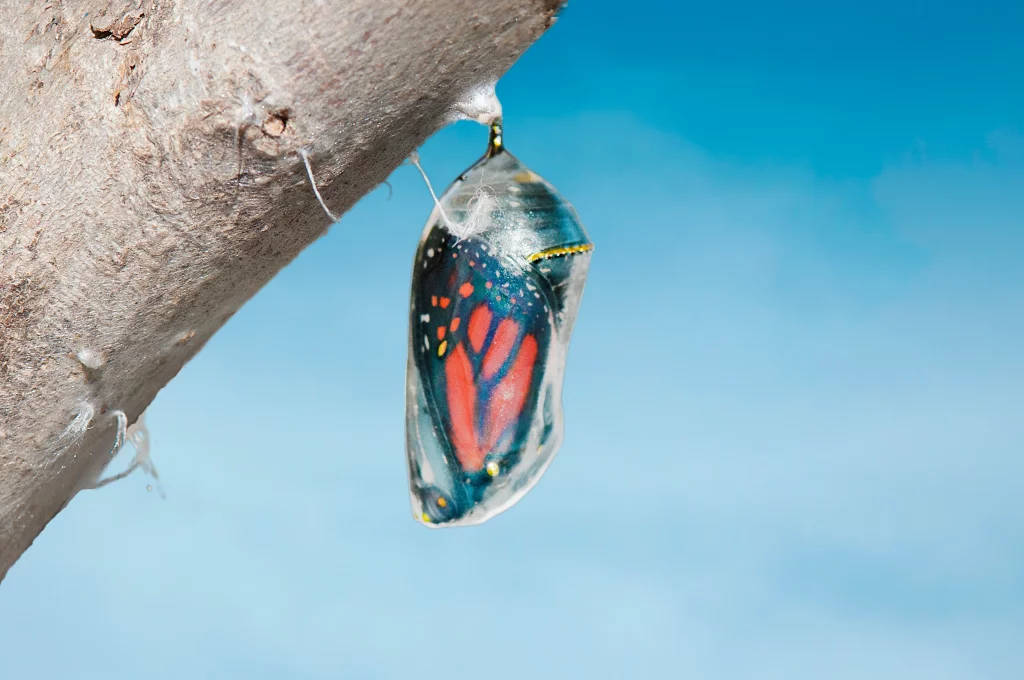Woolly bear caterpillars are fuzzy little creatures we often see crawling around in our gardens and parks. They might look cute and fluffy, but did you ever think when they make their warm cocoons? These caterpillars have a special way of changing into butterflies or moths, starting with cocooning.
But when exactly does this happen? We’ll learn about the woolly bear caterpillar’s life cycle and the signs that tell us when they’re ready to build their cocoons, so if you’re curious about when woolly bear caterpillars undergo this wonderful change.
By the end, you’ll have a clear picture of when these caterpillars cocoon and what you can do to observe this incredible process up close.
The Life of a Woolly Bear Caterpillar

These caterpillars are baby Isabella tiger moths. They start as tiny caterpillars from eggs in late summer or early fall. You can easily see woolly bear caterpillars because they look soft and have black and reddish-brown stripes on their bodies. These stripes are just a part of their look, and they don’t tell us about the winter like some people think. When they are caterpillars, woolly bears eat a lot of plants, mostly leafy ones.
As they get bigger, they shed their old skin a few times to fit their growing bodies. This caterpillar stage can last for a few weeks or months, depending on where they live, how much food they find, and how fast they grow.
Cocooning the Metamorphosis Begins

Nature always surprises us with its amazing changes, and one of the most fascinating examples is the change of the woolly bear caterpillar. This little critter, with its striped look, goes through a big change called cocooning. You can find woolly bear caterpillars in many parts of North America.
At first, these caterpillars are tiny and hungry, eating leaves and getting bigger. But when they reach a certain point, they prepare for their big change. Like a warm blanket, they spin a protective cocoon around themselves and hide away from the outside.
Inside this cocoon, something amazing happens. The caterpillar changes a lot, both in how it looks and what it becomes. It breaks down its old body and emerges as a completely different creature called the Isabella tiger moth.
This change isn’t just about looks, it’s a symbol of starting fresh and growing. Cocooning reminds us that change is a natural part of life. From the plain woolly bear to the beautiful moth, every stage of the change is something to admire.
How Does a Caterpillar Make a Cocoon?

Transforming a caterpillar into a butterfly captivates the imagination, a process detailed in the comprehensive chart for fuzzy caterpillar types. Initially, the caterpillar seeks a secure location to construct its unique covering, producing a liquid that hardens into a robust material upon drying.
Then, it wraps itself in thismaterial, making it a safe home. Inside this home, big changes happen. The caterpillar’s body goes through a big change. Old parts break down, and new parts combine to make the butterfly.
After a few weeks or months, depending on the type of butterfly and where it is, it comes out of its home. It spreads its wings to show its beautiful colors and patterns. This process shows how amazing nature can be, as a caterpillar becomes a butterfly.
Do All Caterpillars Make Cocoons?
Caterpillars are fascinating creatures that go through big changes. Some people think of a safe home when considering caterpillar changes, but not all caterpillars do that. Moth caterpillars are famous for making homes called cocoons. They create these homes using a special material they produce, and inside, they change into moths.
Butterfly caterpillars, however, don’t make cocoons. They create something called chrysalises. These are tough cases made from their skin; they stay safe inside while turning into butterflies.
Some caterpillars are even more special. They don’t make any home around them. They change out in the open and use their appearance or tricks to hide from animals that might want to eat them.
So, not all caterpillars make homes like cocoons or chrysalids. Nature shows us how different and interesting these little creatures are when they change into something new.
When Do Woolly Bear Caterpillars Cocoon?
Woolly bear caterpillars turn into cocoons at different times because of where they live and the weather. Usually, they start making their cocoons in late summer or early fall. This matches their natural cycle because they must change into moths before winter.
Woolly bears pay attention to the temperature and how long the days are. When they notice it’s getting colder and the days are getting shorter, they know winter is coming. That’s when they decide to prepare and make their cocoons to stay safe in the cold months.
Conclusion
Woolly bear caterpillars cocoon when they’re ready to become moths. These fuzzy little creatures spend their time munching on leaves and growing. When they feel it’s time to change, they’ll find a warm spot, spin a silk thread, and create a cocoon around themselves.
It might take a few weeks or even months to change completely. When it’s getting colder, they’re more likely to start wrapping. So, if you see a woolly bear caterpillar making a cocoon, just let it be and watch the beauty of nature.
Someday, that cocoon will open up as a beautiful moth, ready to find life.

